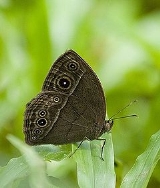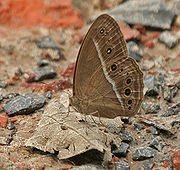
Mycalesis perseus
Encyclopedia
The Dingy Bushbrown or Common Bushbrown (Mycalesis perseus) is a species of satyrine
butterfly
found in South Asia
and Southeast Asia
.
Satyrinae
Satyrinae, the satyrines or satyrids, commonly known as the Browns, is a subfamily of the Nymphalidae . They were formerly considered a distinct family, Satyridae. This group contains nearly half of the known diversity of brush-footed butterflies...
butterfly
Butterfly
A butterfly is a mainly day-flying insect of the order Lepidoptera, which includes the butterflies and moths. Like other holometabolous insects, the butterfly's life cycle consists of four parts: egg, larva, pupa and adult. Most species are diurnal. Butterflies have large, often brightly coloured...
found in South Asia
South Asia
South Asia, also known as Southern Asia, is the southern region of the Asian continent, which comprises the sub-Himalayan countries and, for some authorities , also includes the adjoining countries to the west and the east...
and Southeast Asia
Southeast Asia
Southeast Asia, South-East Asia, South East Asia or Southeastern Asia is a subregion of Asia, consisting of the countries that are geographically south of China, east of India, west of New Guinea and north of Australia. The region lies on the intersection of geological plates, with heavy seismic...
.
Description
.
Wet-season form. Male and female. Upperside dark to somewhat pale vandyke-brown. Fore wing with a white-centred, fulvous-ringed, black ocellus in interspace 2, and rarely a very small but similar ocellus in interspace 5. Hind wing uniform, occasionally two or three postmedian obscure ocelli present. Fore and hind wings with subterminal and terminal pale lines. Underside: the groundcolour, subterminal and terminal lines on the wings as on upper-side, but crossed by a common purplish - white narrow discal fascia. Fore wing with from two to four, hind wing normally with seven ocelli, similar to, but more clearly defined than, the ocelli on the upperside ; on both wings the line of ocelli bordered inwardly and outwardly by sinuous purplish-white lines. On the hind wing only the three posterior ocelli in a straight line, the rest strongly curved outwards. In the female the median or posterior ocellus on the upperside of the fore wing is always larger than in the male.
Dry-season form.- Male and female. Unpperside similar to that in the wet-season form, the median ocellus generally smaller. Underside brown, more or less suffused with purple and irrorated with darker brown minute transverse strigae; the transverse discal band obscure, often merely indicated by black dots at the veins, occasionally bordered outwardly by an ochraceous diffuse band. Ocelli obsolescent, but when present as mere minute dots their arrangement on the hind wing is as in the wet-season form. Antennae, head, thorax and abdomen brown; antennae sometimes cinereous white on the sides with the apex black. Male sex-marks in form 2, but that on the underside of the fore wing small (about 2 into, long) and black.
Expanse 42-54 mm.
Habitat. I have examined specimens from the Himalayas, Kangra to Sikhim and Bhutan; from Bengal, Southern India and Ceylon. This form is fairly common throughout Burma and Tenasserim ; it extends to China and far into the Malayan Subregion.
External links
- FLMNH Excellent photographs of male and female from SulawesiSulawesiSulawesi is one of the four larger Sunda Islands of Indonesia and is situated between Borneo and the Maluku Islands. In Indonesia, only Sumatra, Borneo, and Papua are larger in territory, and only Java and Sumatra have larger Indonesian populations.- Etymology :The Portuguese were the first to...
(authority determined). Subspecies lallilisis Hewitson, 1864.



_butterfly_for_id_img_0771.jpg)